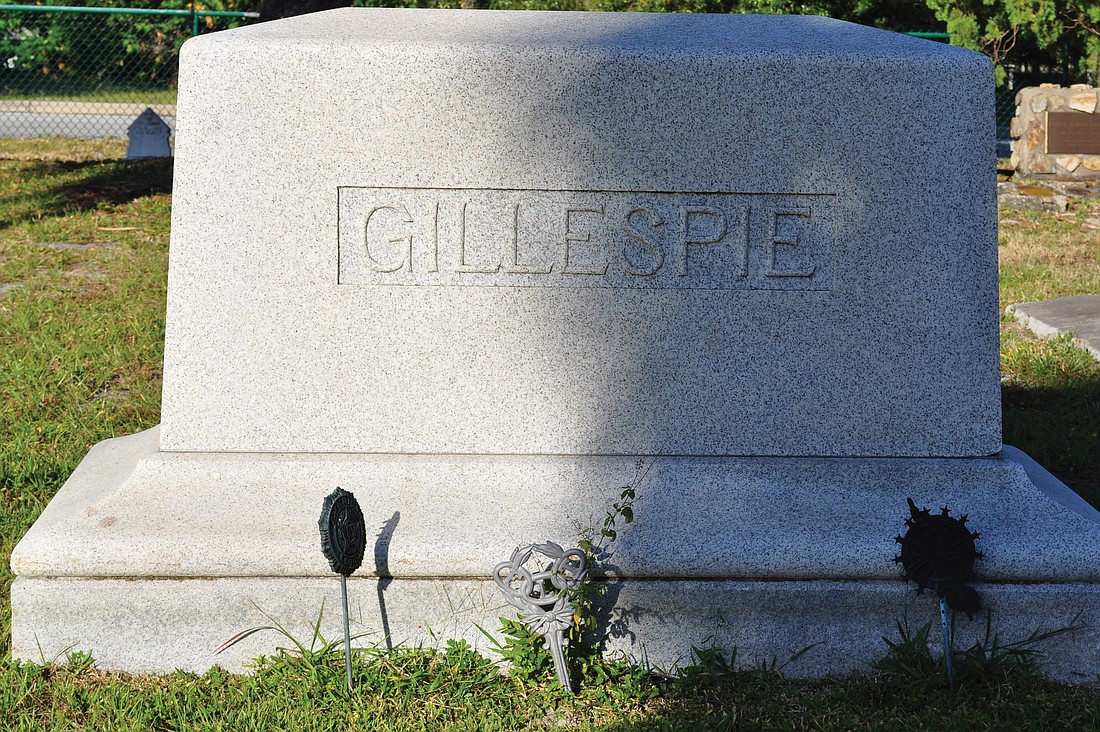- May 10, 2025
-
-
Loading

Loading

St. John’s Memorial Cemetery
Bee Ridge Road and U.S. 41
Florida pines, moss-covered oak trees and a small white church used to sit near the cemetery at U.S. 41 and Bee Ridge, which now backs up to McDonald’s and Saks Fifth Avenue. At first glance, the fenced-in, well-maintained grounds seem like a resting place for only a few people — headstones are far and few between. But in reality, the majority of the plot is occupied by unmarked graves.
These unmarked plots are for people who were only buried with a paper card that was used to designate the person’s remains. They couldn’t afford headstones or grave markers.
The cemetery used to be called “Crocker Graveyard” but changed names in 1901 with a land deed from Florida Mortgage and Investment Co. Crocker Graveyard dates back to the 1870s but its exact beginning is unknown.
The cemetery has been closed to burial since 1982. Elizabeth “Betty” Yarbrough was the last person buried there in 1975, in a plot next to her husband, Roy. She paid $15 for the plot in 1962. Other graves from the 1900s were dugup and moved toward the front of the cemetery to make room for a six-lane highway in 1985.
The plot thickens: In 1997, Bill Whetzel stumbled across what he thought was a pet cemetery. After learning that humans were buried there, he thought the cemetery deserved some attention. Graves had been vandalized, such as Annie Smith Myers’ grave, whose headstone was recovered in four pieces by the police. It was eventually restored. He spent more than 1,300 hours removing 32 tons of debris from the area.
Rosemary Cemetery
Central Avenue and Ninth Street
Rosemary Cemetery is the resting place of the movers-and-shakers of historic Sarasota and is full of recognizable names such as John Hamilton Gillespie, the first mayor; Owen Burns, developer; John and Jane Browning, colonists; and the last names Higel, Pelot, Halton, Stickney, Whitaker and Cunliff. There are approximately 240 people buried on the plot of land at Central Avenue and Ninth Street. Some are veterans of the Civil and Spanish-American wars.
Colonist Tom Booth is noted as having the oldest grave in the cemetery with the date 1887, but it is believed that the first burial was in 1886.
L. H. Cunliff purchased his lot in Rosemary Cemetery from the city for $15. He argued that it was only worth $10, so the city sold him a second lot for $5.
The plot thickens: In 1887, carpenter Elaf Green cut the throat of his wife and three children and drove 20-inch chisels through their necks. He then strolled into Whitaker Hardware Store and announced the brutal acts he had just committed.
William Whitaker and the sheriff took him in a buggy to a place to contain him. En route, Green pushed the sheriff out of the buggy. Whitaker immediately shot him, and Green is buried where he fell. This exact location is unknown. Neighbors near the site of his death reported the area was haunted for years.
Green’s wife and children are buried in Rosemary Cemetery.
Whitaker Cemetery
1232 12th St.
On Dec. 14, 1842, William H. Whitaker sailed into Sarasota as the first white settler and became Manatee’s first sheriff. He built a log cabin for himself, his wife, Mary Jane, and their children. The home overlooked the bay near where the Daughters of the American Revolution home sits today. Whitaker Cemetery was his family’s cemetery.
Grace and Carrie Whitaker, daughters of William and Mary Jane, were the first to be buried in the cemetery in 1879. Whittaker was buried there in 1888. Family members cared for the land after that, and in 1910, Charles C. Whitaker fenced the area and put a vault in for the graves of Whittaker and his wife.
In 1925, Furman Chairs Whitaker, the first native-born doctor in Sarasota, sold the family’s land to a Chicago developer. The buyer sold the land for taxes, and the cemetery became inviolate.
In the 1930s, the graveyard was vandalized. The walls were broken, and the iron entrance gates were stolen. It is believed that the iron was sold for scrap metal during World War II.
The D.A.R. acquired the adjacent land, where they established a chapter house. In 1939, the cemetery was deeded to the D.A.R. in exchange for its care of the graveyard. It has been in its care since.